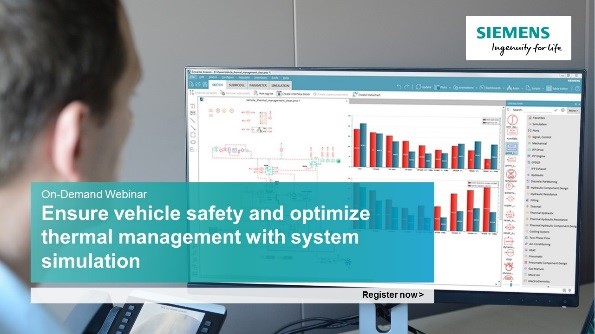Safety first, optimize your vehicle thermal management architecture


Remember the road to family vacations when you were younger. Let’s be honest that this was not always a good memory (not only because of brothers and sisters’ quarrels). Especially in summer… The long hours driving through overcrowded highways, easily doubling your usual time to get there, under a blazing heat, lulled by the engine whirring…
Did I say lulled? A noisy engine was not a good sign because it meant that it started to overheat. And, how do we usually all behave in that case? We attentively watch the engine temperature gauge getting up and we start getting worried about how hot the engine is running and whether it fails or not – but also about the remaining liters of water as the cabin temperature is starting to be unbearable… hoping everything is going good until the traffic jam ceases.
 On the cooler side, some of us like enjoying sporty driving in mountain roads. And push the vehicle performance to its limits. For sure, the driving experience will be thrilling, but there that are the vehicle components which are likely to suffer because of overheating.
On the cooler side, some of us like enjoying sporty driving in mountain roads. And push the vehicle performance to its limits. For sure, the driving experience will be thrilling, but there that are the vehicle components which are likely to suffer because of overheating.
We don’t have to worry anymore – yes, we can cool down. Driver and passengers’ safety is something car makers don’t play with. Indeed they make sure that your vehicle engine temperature remains under a certain level (maximum 110 to 115° C) to avoid any damage.
The variety of driving situations that a car faces during its lifetime requires an efficient cooling system to get your engine temperature under control and give you a great driving experience in terms of comfort and performance. This is only feasible with vehicle thermal management engineering. At Siemens PLM Software, we provide the right tools and methodologies to help thermal engineers design the most optimal vehicle thermal management strategies for each vehicle architecture.

Reaching the best architecture is a real challenge, because vehicle thermal management department in the automotive industry is at the crossroads of different departments. Indeed thermal engineers strongly rely on data coming from engine design colleagues and from the vehicle design department to start engineering the thermal systems and get first thermal evaluation of architectures.
As mentioned above, first purpose of designing cooling systems is to ensure the safety of vehicles in any driving condition and for every possible driving cycles, while reaching the expected level of performance and emissions during vehicle integration. Developing systems that fulfil all – usually contradictory – requirements while keeping control over the project time and costs requires the implementation of simulation solutions that help frontload engineering decisions in early design stages.
In front of such situation you may expect a new methodology to:
– Easily build the missing data (engine maps, heat exchangers performance and air velocity) to get realistic models in pre-design stages, and anticipate on thermal systems sizing and performance even when information is not yet accessible?
– Facilitate early design decisions that will help guaranteeing systems safety while balancing various constraints (costs, time, design requirements, fuel economy…)?
– Seamlessly refine the architecture of your engine and your vehicle according to your thermal management needs in both cases: warm-up and cooling systems at the first stage of your development cycle?

We invite you to watch this 30-minute on-demand webinar where Thomas Desbarats, expert in vehicle thermal management, gives an introduction on our Simcenter system simulation solutions about vehicle thermal management and perform a live-demo “Modeling a cooling system with Simcenter Amesim”


